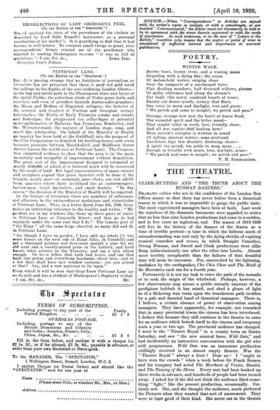PETTICOAT LANE.
[To THE EDITOR OF THE " SPECTATOR."1 &R,—It is passing strange that no Autolycus of journalism or literature has yet perceived that there is good red gold amid the tailings in the depths of the ever-widening London Ghetto— in the hog and cattle path to the Plantagenet styes and byres of the Spital Fields; the suburban abode of Tudor great lords and courtiers and even of proudest Spanish Ambassador-grandees; the Mecca and Medina of Huguenot refugees; the fosterer of the severest and straitest of Puritan and Georgian sectary tabernacles; the Rialto of Early Victorian crooks and cranks and Roderigos; the playground (on cellar-flaps) of potential multi-millionaires of Ballarat, San Francisco, Kimberley, and the Witwatersrand; the nursery of London stage, song, and lunch fine scholarship. On behalf of the Ministry of Health an inquiry has been held at the Guildhall into the proposal of the City Corporation to demolish 144 dwelling-houses and seven business premises between Houndsditch and Middlesex Street (better known the world over as Petticoat Lane). The Corpora- tion submitted evidence to show that the area is in the main insanitary and incapable of improvement without demolition. The gross cost of the improvement designed is estimated at nearly £140,000, of which it is believed much will be recovered by the resale of land. But legal representatives of many owners and occupiers argued that great injustice will be done if the tenants, mostly poor—or seemingly poor—Jews, are cast adrift from quarters where their livelihood lies as costermongers, harrow-men, street marketers, and small dealers. " In due course" the decision of the Ministry of Health will be reported.
In the byways of literature there are numbers of references and allusions to the extraordinary mutations and vicissitudes of Petticoat Lane. Thus, in a letter dated June 4th, 1769, Gray makes an interesting reference to the locality and writes : " My gardens are in my windows like those up three pairs of stairs in Petticoat Lane or Camomile Street; and they go to bed regularly under the same roof that I do." The famous poet of "the Elegy " all the same keeps cheerful, as many did and do in Petticoat Lane, " for though I have no garden, I have sold my estate [it was some houses on the west side of Hand Alley, in Cornhill] and got a thousand guineas and four-score pounds a year for my old aunt and a twenty-pound prize in the Lottery, and Lord knows what arrears in the Treasury, and am a rich fellow enough. Go to—a fellow that bath had losses, and one that hath two gowns and everything handsome about him; and in a few days shall have new window curtains: are you avised of that? Aye, and a new mattress to lie upon."
From which it will be seen that Gray knew Petticoat Lane (as we do not) and was a student of Shakespeare's Dogberry withal.


































 Previous page
Previous page